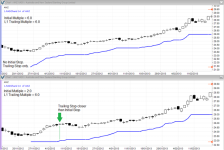
The following scenarios show the different ways that the RAD Chandelier can be configured. In its simplest form it is just a single trailing stop based on price volatility. Advanced options have been supplied so that the indicator can be configured for many of the popular uses, such as including a break even transition.
In the following charts, the RAD Chandelier is shown functioning in Simple mode with two scenarios.
Firstly, with only a trailing stop component specified by the ‘L1 Trailing Multiple’. The initial stop is effectively disabled by setting the multiple equal to or larger than the trailing. Secondly, with both an initial stop and trailing stop components.
In the following charts, the RAD Chandelier is shown functioning in Break Even mode. Firstly, with the ‘Initial Mode’ set to Fixed and then Trailing.
In both scenarios, when the price component (‘Level Trigger’) exceeds the level specified by the ‘Level 1 Multiple’ the stop moves to using the ‘Entry Price‘ and a trailing stop specified by the ‘L1 Trailing Multiple’ as components. The closest component is used.
In the following charts, the RAD Chandelier is shown functioning in Simple mode with two additional transitions levels. The additional transition levels allow the stop to be tightened when they are touched or crossed.
The RAD Chandelier starts with the standard Initial stop and a Trailing stop specified by the ‘L1 Trailing Multiple’.
When the price component (‘Level Trigger’) exceeds the level specified by the ‘Level 2 Multiple’, the stop moves to using the trailing stop specified by the ‘L2 Trailing Multiple’.
When the price component (‘Level Trigger’) exceeds the level specified by the ‘Level 3 Multiple’, the stop moves to using the trailing stop specified by the ‘L3 Trailing Multiple’.
© Copyright Quantum Methodologies, 2014.
ALL RIGHTS RESERVED
Send Feedback on this topic to Beyond Charts.